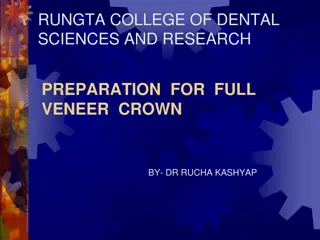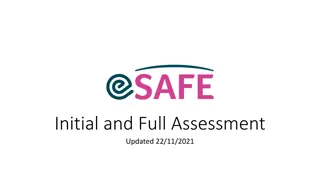
Urban Vertiport Assessment and Mobility Operations Technology Overview
Explore NASA's Vertiport Assessment and Mobility Operations System (VAMOS!) technology for urban vertiport planning and assessment. Contact Jay Singh at NASA Ames Research Center for more information. Evaluate vertiport locations based on key factors in metropolitan areas to support Advanced Air Mobility campaigns. Address new challenges faced by cities and metropolitan planners in optimizing traffic and service delivery for varied applications and services. Learn how this software tool can help in identifying suitable vertiport locations.
Download Presentation

Please find below an Image/Link to download the presentation.
The content on the website is provided AS IS for your information and personal use only. It may not be sold, licensed, or shared on other websites without obtaining consent from the author. If you encounter any issues during the download, it is possible that the publisher has removed the file from their server.
You are allowed to download the files provided on this website for personal or commercial use, subject to the condition that they are used lawfully. All files are the property of their respective owners.
The content on the website is provided AS IS for your information and personal use only. It may not be sold, licensed, or shared on other websites without obtaining consent from the author.
E N D
Presentation Transcript
Lab to Business Technology Presentation 3 September 27, 2022 Visit our new website: www.uascluster.com
Vertiport Assessment and Mobility Operations Vertiport Assessment and Mobility Operations System (VAMOS!) System (VAMOS!) A tool to support urban Vertiport location planning and assessment NASA Ames Research Center (ARC) Mountain View, CA Moffett Federal Airfield in California's Silicon Valley For technology questions, contact Jay Singh at NASA Ames Research Center Email: jayinder.singh@nasa.gov For NASA licensing support, contact Cory Abercrombie Email: cory.m.abercrombie@nasa.gov Jack James: jjames@dcnteam.com 2
Vertiport Assessment and Mobility Vertiport Assessment and Mobility Operations System (VAMOS!) Operations System (VAMOS!) Technology overview description NASA developed software tool and algorithm based on Advanced Air Mobility campaign and research projects Evaluates suitability of vertiport location and vertiport network in a metropolitan area Evaluation based on key factors as characterized in research along with city specific goals and objectives. A vertiport refers to a physical structure for the departure, arrival, and parking/storage of AAM vehicles. Jack James: jjames@dcnteam.com 3
Vertiport Assessment and Mobility Vertiport Assessment and Mobility Operations system (VAMOS!) Operations system (VAMOS!) Problem Description New challenge for Cities and Metropolitan area (intercounty) planners Support competitive business environment Varied applications and services delivery, first responders, personal transport, inspection.. A new layer of activity and traffic optimized locations and corridors Varied vehicle designs and capabilities Urban infrastructure should be ready as new vehicles and applications are ready Widespread adoption of AAM concept will necessitate urban vertiport networks that optimize traffic and service delivery. Throughout a geographical and metropolitan region. Need for tool and method to systematically evaluate and quantify suitability of individual vertiport locations along with an urban vertiport network Jack James: jjames@dcnteam.com 4
Vertiport Assessment and Mobility Vertiport Assessment and Mobility Operations System (VAMOS!) Operations System (VAMOS!) Technology solution Software planning and decision support tool Identify geographical locations suitable for vertiport Evaluate suitability of identified locations. Evaluate specific locations along with local subregions Suitability evaluation factors include zoning, land use, transit stations, fire stations, noise, and time-varying factors like congestion and demand The technology enables customization of assessment factors for the local cities and communities Provides graphical location suggestions for vertiport selection, risk assessment, economic analysis, etc. Offers flight route structure design (for avoidance of weather, noise, risk management, etc.) Candidate vertiport locations are refined by establishing feasibility of flight between them Includes a modeling component and a simulation component. Open architecture Jack James: jjames@dcnteam.com 5
Vertiport Assessment and Mobility Vertiport Assessment and Mobility Operations system (VAMOS!) Operations system (VAMOS!) Market opportunity City planners will need better understanding of AAM and Vertiports Current projects work with a few 'prototype' cities and areas Will need to expand this to other cities Could be a consultancy for planning and ongoing operations Also requires knowledge of new and developing technologies and vehicles New and unique view of urban planning and development Jack James: jjames@dcnteam.com 6
Vertiport Assessment and Mobility Vertiport Assessment and Mobility Operations system (VAMOS!) Operations system (VAMOS!) IP and Collaboration Patent pending but very active research area and Look at collaboration agreement Many research papers, presentation and developed knowledge associated with NASA AAM campaign and partners Expect software release Technology Maturity Operating prototype that has been demonstrated to a couple prototype cities and is in active development Modeled and presented to several cities LA, Dallas, others Development requirements supported by broad group of organizations and researcher Research on key factors, implementation of factors and user interface Jack James: jjames@dcnteam.com 7
Vertiport Assessment and Mobility Vertiport Assessment and Mobility Operations system (VAMOS!) Operations system (VAMOS!) A tool to support urban Vertiport location planning and assessment For further information contact: NASA Ames Research Center (ARC) Mountain View, CA Moffett Federal Airfield in California's Silicon Valley For technology questions, contact Jay Singh at NASA Ames Research Center Email: jayinder.singh@nasa.gov For NASA licensing support, contact Cory Abercrombie Email: cory.m.abercrombie@nasa.gov Jack James: jjames@dcnteam.com 8
Unmanned Aerial Systems (UAS) Traffic Management Unmanned Aerial Systems (UAS) Traffic Management Traffic management system for Unmanned Aerial Systems (UASs) to maintain safe and efficient UAS operations NASA Ames Research Center (ARC) Mountain View, CA Moffett Federal Airfield in California's Silicon Valley For technology questions, contact Jay Singh at NASA Ames Research Center Email: jayinder.singh@nasa.gov For NASA licensing support, contact Cory Abercrombie Email: cory.m.abercrombie@nasa.gov Jack James: jjames@dcnteam.com 9
Unmanned Aerial Systems (UAS) Traffic Management Unmanned Aerial Systems (UAS) Traffic Management Technology overview description A traffic management system for Unmanned Aerial Systems (UASs) to maintain safe and efficient UAS operations Developed through system engineering methods Supports evolving and adaptable operations concepts Adaptable to local needs Can organize into zones or 'cellular' as needed Jack James: jjames@dcnteam.com 10
Unmanned Aerial Systems (UAS) Traffic Management Unmanned Aerial Systems (UAS) Traffic Management Problem Description Forecast is that UAV, UAS traffic will significantly increase with varying forms of activities Traffic will need to be organized and optimized There will be restrictions and boundaries Can be established or dynamic Activities, corridors and boundaries can vary with areas, timeframes, weather much of activity will occur in class G airspace Out of traditional ATC areas Jack James: jjames@dcnteam.com 11
Unmanned Aerial Systems (UAS) Traffic Management Unmanned Aerial Systems (UAS) Traffic Management Technology solution Can tailor services to local needs and requirements, vehicle types and operations Dynamic, responsive to traffic density, dynamics and municipal requirements Can allow separate multiple providers that provide local modular' support to broader region (metropolitan area) Dynamic geofencing Account for weather dynamics Developed through NASA AAM initiatives Feature rich Market opportunities Software services Operations services Training Could specialize to service types Jack James: jjames@dcnteam.com 12
Unmanned Aerial Systems (UAS) Traffic Management Unmanned Aerial Systems (UAS) Traffic Management IP and Collaboration Patent Number US 10,332,405 B2 Patent Issued: 06/25/2019 Application filed : 12/19/2014 Assigned to NASA 2015-01-05 Adjusted expiration: 05/19/2036 Notable inventor is Parimal Kopardekar (PK) Director of NASA Aeronautics Research Institute (NARI) Collaboration opportunity Technology Maturity Part of active research initiative Many features implemented If interested, look into demo Jack James: jjames@dcnteam.com 13
Unmanned Aerial Systems (UAS) Traffic Management Unmanned Aerial Systems (UAS) Traffic Management Traffic management system for Unmanned Aerial Systems (UASs) to maintain safe and efficient UAS operations NASA Ames Research Center (ARC) Mountain View, CA Moffett Federal Airfield in California's Silicon Valley For more information: For technology questions, contact Jay Singh at NASA Ames Research Center Email: jayinder.singh@nasa.gov For NASA licensing support, contact Cory Abercrombie Email: cory.m.abercrombie@nasa.gov Jack James: jjames@dcnteam.com 14
UAV UAV- -based foreign object debris (FOD) detection based foreign object debris (FOD) detection System and method for unmanned aerial vehicle (UAV)-based foreign object debris (FOD) detection A system to identify foreign object debris on runways, taxiways, and tarmacs using swarm of UAVs Naval Postgraduate School Monterey, CA Contact Derek Mayer at TechLink Email: Derek.mayer@techlinkcenter.org David Scott at TechLink Email: david.scott@techlinkcenter.org Jack James: JJames@dcnteam.com 15
UAV UAV- -based foreign object debris (FOD) detection based foreign object debris (FOD) detection Technology overview description A computer-based system and method allows a user to automatically and aerially inspect a selected runway, taxiway, or tarmac surface for foreign object debris (FOD) using a plurality of UAVs equipped with electro-optical (EO) sensors. Information about and images of candidate FOD are displayed to the user allowing the user to determine whether to send a team to remove the FOD from the runway. Jack James: JJames@dcnteam.com 16
UAV UAV- -based foreign object debris (FOD) detection based foreign object debris (FOD) detection Problem Description Debris or unwanted objects on runways may cause damage to aircraft and jet engines and tires also injury to ground personell manual inspection is slow and human resource intensive large airports have elaborate realtime systems visual FOD detection by humans is found to be not reliable Smaller objects can increase wear and maintenance costs Jack James: JJames@dcnteam.com 17
UAV UAV- -based foreign object debris (FOD) detection based foreign object debris (FOD) detection Technology solution A 'swarm' of UAVs fly down the runway Live images of the runway surface captured by the EO sensors are transmitted from the UAVs during an inspection sweep of the runway surface Imagery is connected and processed through the software application and GUI Images compared with FOD-free reference images of the runway surface could also observe overall runway structural conditions Jack James: JJames@dcnteam.com 18
UAV UAV- -based foreign object debris (FOD) detection based foreign object debris (FOD) detection Market opportunity May be cost effective solution for medium or smaller airports Possibly lower traffic airports larger civil airports have sophisticated FOD detection systems real time detection for high traffic runways Jack James: JJames@dcnteam.com 19
UAV UAV- -based foreign object debris (FOD) detection based foreign object debris (FOD) detection IP and Collaboration US Patent information US 11,281,905 B2 Application filed: 09/12/2019 Assigned to THE UNITED STATES OF AMERICA, AS REPRESENTED BY THE SECRETARY OF THE NAVY Patent issued 03/22/2022 Adjusted expiration 03/12/2040 Open to collaboration Technology Maturity Application and User interface prototyped in Matlab Research papers published Jack James: JJames@dcnteam.com 20
UAV UAV- -based foreign object debris (FOD) detection based foreign object debris (FOD) detection System and method for unmanned aerial vehicle (UAV)-based foreign object debris (FOD) detection system to identify foreign object debris on runways, taxiways, and tarmacs using swarm of UAVs Naval Postgraduate School Monterey, CA Contact Derek Mayer at TechLink Email: Derek.mayer@techlinkcenter.org David Scott at TechLink Email: david.scott@techlinkcenter.org Jack James: JJames@dcnteam.com 21
UAV UAV- -based point, distance, and velocity based point, distance, and velocity measurement system for ground targets measurement system for ground targets UAV and camera system to precisely measure location and movement of ground points or objects Naval Surface Warfare Center - Corona Corona California Contact Derek Mayer at TechLink Email: Derek.mayer@techlinkcenter.org David Scott at TechLink Email: david.scott@techlinkcenter.org Jack James: JJames@dcnteam.com 22
UAV UAV- -based point, distance, and velocity based point, distance, and velocity measurement system for ground targets measurement system for ground targets Technology overview description An aerial platform-based measurement system to measure distances, determine ground points, analyze the speed of moving objects, and perform other velocity measurements and analyses System can monitor vehicular velocities over a diversity of terrain, such as flat or irregular ground Jack James: JJames@dcnteam.com 23
UAV UAV- -based point, distance, and velocity based point, distance, and velocity measurement system for ground targets measurement system for ground targets Problem Description When precision measurement of position or movement data on an object or target is needed For typical object without a GNSS (GPS) or when greater precision is required Some simple examples Military ballistic munition accuracy, testing and training Law enforcement for forensics, pursuit, monitoring traffic Sports performance Traditional solutions can be expensive to operate or deploy, manually intensive or time consuming to operate or deploy, and/or do not offer real-time results. Jack James: JJames@dcnteam.com 24
UAV UAV- -based point, distance, and velocity based point, distance, and velocity measurement system for ground targets measurement system for ground targets Technology solution Technology uses down looking camera Camera stabilized separately from UAS platform to maintain precise down looking image Inertial Measurement Unit Gimbal control unit Precision is based on laser rangefinder or lidar, an altimeter, or any other device configured for distance measurement between a ground point and camera Uses geo reference data and distance measuring sensors (e.g. laser) to establish reference Field of View (FoV) From reference FoV, can determine location and motion Can 'score' for performance measurements Precision determination of position and movement quickly and autonomously Lower cost compared to some other methods Jack James: JJames@dcnteam.com 25
UAV UAV- -based point, distance, and velocity based point, distance, and velocity measurement system for ground targets measurement system for ground targets Market opportunity Military for artillery performance Any measurement of ballistic performance Law enforcement for some applications or forensics Sports performance Possible agriculture or conservation Possible infrastructure Jack James: JJames@dcnteam.com 26
UAV UAV- -based point, distance, and velocity based point, distance, and velocity measurement system for ground targets measurement system for ground targets IP and Collaboration Patent. U.S. Patent 11,140,326 application 5/23/2016 Issued 10/5/2021 Adjusted expiration 8/9/2038 assigned to Secretary of Navy appears to have filed PCT Licensing available Collaboration with NAVY researchers Technology Maturity Contact for latest Patent describes straightforward method Will need testing to characterize precision for different applications Somewhat UAV platform independent, can use variety of currently available vehicles Jack James: JJames@dcnteam.com 27
UAV UAV- -based point, distance, and velocity based point, distance, and velocity measurement system for ground targets measurement system for ground targets UAV and camera system to precisely measure location and movement of ground points or objects Naval Surface Warfare Center - Corona Corona California For more information contact Derek Mayer at TechLink Email: Derek.mayer@techlinkcenter.org David Scott at TechLink Email: david.scott@techlinkcenter.org Jack James: JJames@dcnteam.com 28






















